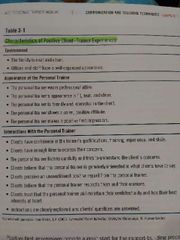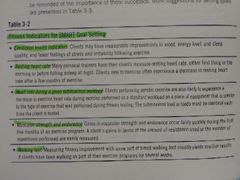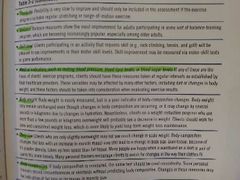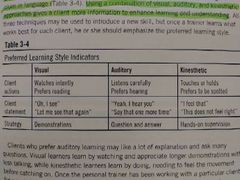![]()
![]()
![]()
Use LEFT and RIGHT arrow keys to navigate between flashcards;
Use UP and DOWN arrow keys to flip the card;
H to show hint;
A reads text to speech;
52 Cards in this Set
- Front
- Back
|
What are the 4 stages of the client-trainer relationship |
-Rapport -Investigation -Planning -Action
|
|
|
Rapport refers to |
Mutual understanding and trust Using both verbal and nonverbal communication Builds over time Relationship of client and trainer *the foundation of every stage of the ACE integrated fitness training model* |
|
|
Investigation stage involves |
Understanding the client and eliciting a much information about the client Good listening skills |
|
|
True or false: Excellent communication skills and teaching techniques are essential during all of these stages |
True |
|
|
Rapport stage: Characteristics of positive client-trainer experiences |

|
|
|
Rapport stage: Nonverbal communication |
-Voice quality: firm,confident -Eye contact: direct eye contact fire center of attention -Facial expressions: sincere emotion -Hand gestures: relaxed,fluid hand gestures -Body position: Open, well balanced, erect biddy positioning |
|
|
Investigation stage: Gathering information |
-Use this stage to understand client likes and dislikes -Ask about previous experiences with physical activity to uncover factors that furthered or disrupted adherence -Learn clients personal preferences -What has work may not work |
|
|
Investigation stage: Demonstrating effective listening: -Paraphrasing |
Restating clear and concise way the essence of what client has been saying. May extend making of client's answer |
|
|
Investigation stage: Demonstrating effective listening: -Encouraging |
May use phrases "I see" "yes" "I know what you mean"Nodding and smiling Indicate person is listening and encourage speaker to continue |
|
|
Investigation stage: Demonstrating effective listening: -Questioning |
Open ended questions demonstrate good listening and encourage client share relevant info |
|
|
Investigation stage: Demonstrating effective listening: -Reflecting |
Seek clarification by restate main points and feelings Move the convo in productive direction and indicate effective listening |
|
|
Investigation stage: Demonstrating effective listening: -Summarizing |
Summarize key points that have a bearing on exercise program design Direct convo on track and keep appointment on track |
|
|
True or false: Trainers may not choose to reveal similar personal experiences to indicate that they understand a client's position |
False: May chose to |
|
|
Investigation stage: Responding to difficult disclosures |
Short response such as "I am sorry" "that must of been very hard" or "I can't imagine how difficult that must have been for you and your family" Can turn this convo back to practical details Client to seek professional help if client success from depression, eating disorder, or other sis health problems |
|
|
Planning stage: Client adherence is better when clients take responsibility for exercise program design by |
-Setting goals -Generating and discussing alternatives -Formulating a plan -Evaluating the exercise program |
|
|
Planning stage: What are the SMART goals |
-Specific -Measurable -Attainable -Relevent -Time-bound |
|
|
Planning stage: SMART goal: -Specific |
Goals must be clear and unambiguous stating what should be accomplished |
|
|
Planning stage: SMART goal: -Measurable |
Goals must be measurable so clients know if they are making progress |
|
|
Planning stage: SMART goal: -Attainable |
Realistic Reinforces commitment to the program and encourages client to continue Attaining goals is a testimony to trainers effectiveness |
|
|
Planning stage: SMART goal: -Relevant |
Goals must be relevant to particular interests, needs, and abilities of individual client |
|
|
Planning stage: SMART goal: -Time-bound |
Goals must contain estimated timelines for completion Clients should be evaluated regularly to monitor progress |
|
|
Process goal is |
Something a client does |
|
|
Product goal is |
Is something achieved |
|

Planning stage: SMART goal: Fitness indicators |

|
|
|
Planning stage: SMART goal: Motivate clients for longterm adherence |
Break large goals(reachable 6 months or more) into small goals(8 to 10 weeks) and even weekly goals (completing certain number of exercise sessions)
Reevaluate and revise goals and exercise recomendations periodically to prevent discouragement if large goals not being met |
|
|
The ultimate goal for every client is adherence to the |
Exercise program |
|
|
Planning stage: Formulate plan |
Help client feel prepared to begin program Clients appreciate advice on clothing, location, facility etiquette and customs Guidance on "fitting in"
|
|
|
Planning stage: Evaluate the exercise program |
Discuss what is working and needs to change. Clients reassessed periodically to measure progress toward goals. Programs modified as necessary to provide realistic or challenging stimuli. If adherance is faltering, trainer and client should discuss what is causing the problem. |
|
|
Planning stage: Using motivational interviewing techniques |
Refers to a method of speaking with people in a way that motivates them to make a decision to change their behavior Trainer goal is to create awareness in clients that a sedentary lifestyle will likely cause health problems |
|
|
Planning stage: Motivational interviewing techniques -Ask probing questions |
Ask open ended questions about daily activities, health concerns and physical activity history |
|
|
Planning stage: Motivational interviewing techniques -Listen carefully |
Trainer can uncover valuable info and show client they are respected |
|
|
Planning stage: Motivational interviewing techniques -Provide educating info |
Trainer can explain dangers of sedentary lifestyle and the health benefits of exercise |
|
|
Planning stage: Motivational interviewing techniques -Keep convo friendly |
Avoid heated arguments Don't make client defensive Trainer should switch to neutral info gathering questions Trainer should express empathy |
|
|
Planning stage: Motivational interviewing techniques -Build self confidence |
Trainer can help client identify areas of success no matter how small. Example being dog walking..increase time by minute or 2 each week |
|
|
Planning stage: Motivational interviewing techniques -Encouraging clients to generate ideas |
Trainer should let clients take lead in making suggestions that might work for them if client seems willing to make small changes |
|
|
Action stage: Setting up self monitoring systems |
Self-monitoring is one of the most effective ways to support behavioral change Self monitoring helps in two ways: One: Increase client self awareness. Acts as a mirror to give clients a more objective view of their behavior And Two: enhance client-trainer communication |
|
|
Action stage: Prefered learning style indicators |

|
|
|
Tell me and I'll forget Show me and I may remember Invole me and I'll |
Underatand |
|
|
Action stage: Motor learning Remind beginners that it takes time and practice to improve motor skills |
Motor skills are strongly related to practice and experience than to natural ability alone |
|
|
Action stage: Motor learning Introduce new skills slowly and clearly |
Explanations should be short and clear Skills explained in terms of what skill is accomplishing or why it's important Explaining goal of movement |
|
|
Action stage: Providing feedback |
Trainer should limit feedback to few simple points and avoid overloading the client with info. Feedback phrased positively. Trainer decide which errors are the most important to correct first which typically involve safety, occur earliest in movement sequence. |
|
|
If personal trainers are not personally passionate about physical activity, they will lack |
Persuasive power |
|
|
Action stage: Effective modeling |
Expose clients to role models similar to themselves. People who see people like themselves exercising will develop more confidence in their own exercise abilities. People more likely to adopt exercise habit if trainers model idea that exercise improves quality of life rather those that conform to unrealistic societal standards. |
|
|
Action stage: Behavorial change contracts |
Must be set to good expectations; not too high or not too low. |
|
|
People who enjoy exercising because it feels good or they enjoy the competition are |
Intrinsically motivated |
|
|
Strategies for effective communication: Cultural competence increase empathy and rapport |
Cultural competence: ability to communicate and workneffectively withnpeople from different cultures |
|
|
Strategies for effective communication: Dufficult clients reqiure more effort |
Trainers who behave professionally and try to understand their clients often win thenhearts and trust of even the most reluctant clients |
|
|
Strategies for effective communication: Empathy and rapport enhance adherance |
Research suggests that time spent establishing a good working relationship enhances adherances. |
|
|
Stage of learning and their application to the client-trainer relationship: Cognitive stage of learning |
Clients try to understand the new skill. When new motor skills are being learned. Use the "tell, show, do" |
|
|
Stage of learning and their application to the client-trainer relationship: Associative stage of learning |
Ready for specific feedback that will help them refine the motor skills |
|
|
Stage of learning and their application to the client-trainer relationship: Autonomous stage of learning |
Less teaching and more monitoring |
|
|
Personal trainers working with athletes and clients trying to master complex motor skills, such a skiing or other sports may find the what less helpful |
Fitts and Posner |

